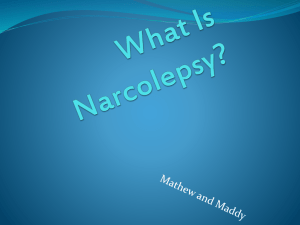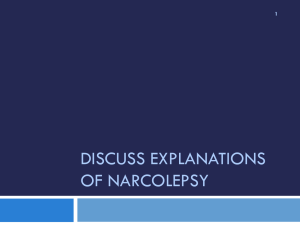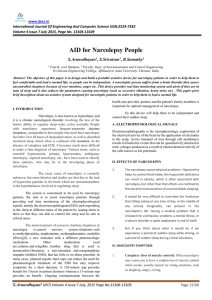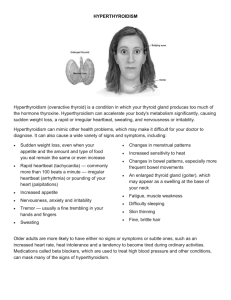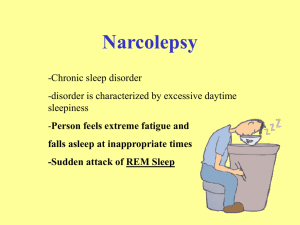Narcolepsy - The Grange School Blogs
advertisement
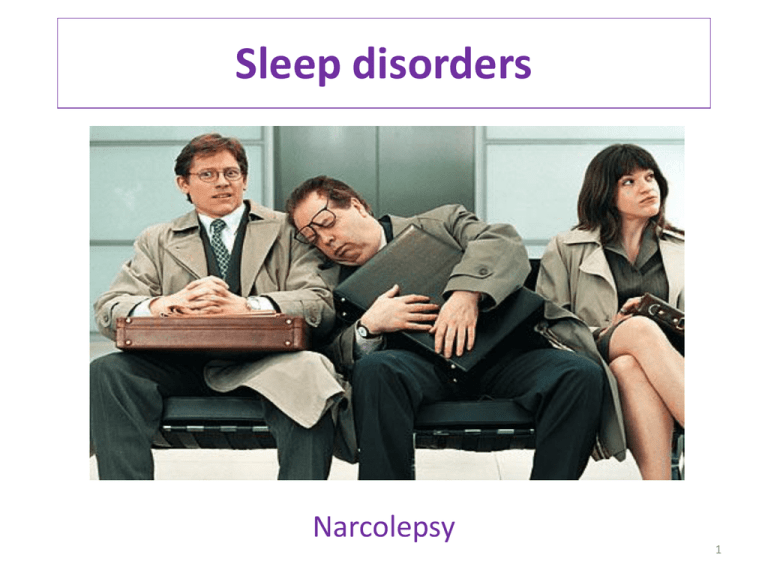
Sleep disorders Narcolepsy 1 Incidence & symptoms • Narcolepsy usually begins in adolescence or early adulthood, and continues through the person’s life • It is thought that 1 in 2000 people suffer from narcolepsy but it is difficult to get an accurate measure of incidence as some people only have mild symptoms or just don’t go to their doctors • Sufferers experience sudden and uncontrollable attacks of sleep • These are at irregular and unexpected times • The two main symptoms are feeling sleepy a lot of the time, and a loss of muscular control • Episodes are often triggered by emotional arousal such as anger, fear, amusement, stress or anxiety • Other symptoms can include hallucinations and sleep paralysis (both experienced either when falling asleep or when waking up), and frequent waking up when asleep at night 2 Explanations of narcolepsy 1 – AO1 • In the 1960s it was considered that it occurred as a result of a malfunction in the systems which maintain REM sleep • Vogel (1960) found that REM sleep occurred at the onset of sleep in narcoleptics • This explained some of the symptoms of the disorder, such as the loss of muscle tone (found in REM sleep) and the hallucinations (seen as REMtype sleep and dreams intruding into the day) 3 Explanations of narcolepsy 2 – AO1 • In the 1980s research suggested that it was linked to a mutation of the immune system • Honda et al (1983) found an increased frequency of one type of human leukocyte antigen (HLA) in patients • HLA molecules coordinate the immune response and are found on the surface of white blood cells 4 Explanations of narcolepsy 3 – AO1 • In the 1990s research has shown a link between low levels of hypocretin (a neurotransmitter) and the disorder • Hypocretin is thought to play a role in maintaining wakefulness • Lin et al (1999) found that narcoleptic dogs had a mutation in a gene on chromosome 12 which disrupted the way that hypocretin was processed 5 AO2 (approaches) • Most of the theories of narcolepsy stem from the biological approach as they implicate abnormalities of genetic factors, the immune system and biochemistry • As such they would also advocate treatment using biological methods such as drug therapy to try to combat sleep onset in the day, and to combat insomnia at night • An alternative approach, such as the psychoanalytic one, would explain narcolepsy quite differently • It would argue that the sudden onset of sleep are ways of disguising sexual fantasies and arousal, or ways of coping with them and reducing the anxiety and distress that they may cause • This is what Lehrman & Weiss (1943) proposed in 1943 • However, this is a minority view and generally psychoanalytic explanations are not accepted outside strict psychoanalytic circles • Furthermore, given that the disorder has clear physiological elements, an inclusive explanation of the disorder would need to refer to biological factors • Therefore, it might have more explanatory value to use a biopsychosocial framework to explain narcolepsy 6 AO3 (refers to Res Meth issues) • Much of the research on narcolepsy uses animal samples, especially dogs • Whilst such research may be able to suggest which factors may be involved in animals, such findings cannot be extrapolated and generalised to humans • This is because the anatomy & physiology of humans and animals are different • And also because sleep patterns (such as when, where and how much) may be different in humans and animals • Similarly, as humans can think about things that they experiences in a way which animals cannot, this may mediate and therefore moderate sleep patterns • Both of these issues mean that what is true for animals may not be true for us • Findings become more reliable when they are initially achieved in animals and then replicated in humans 7 AO2 (commentary) • The most promising explanation of narcolepsy appears to be that of low hypocretin • Findings in dogs have been replicated in humans • Nishino et al (2000) found that humans had low levels of hypocretin in their CSF • However, what might explain these low levels is unclear as human narcolepsy does not run in families in the way that many forms of psychopathology do (eg. schizophrenia) • Mignot (1998) found that there was no significant increased risk of one twin developing narcolepsy if the other twin had it • It could be that the hypocretin abnormalities are caused by brain injury, infection, diet, stress or an auto-immune attack • The auto-immune aspect would link with the HLA abnormalities found by Honda et al (1983) 8 AO2 (debates) • The explanations of narcolepsy such as those HLA and hypocretin can be seen as reductionistic • This is because they attempt to reduce this complex multi-system disorder to malfunctions of a specific biological system and ignore the role of other biological variables as well as those of environmental ones • Whilst such physiological reductionism is necessary for research purposes, where it also occurs at a theoretical level, it oversimplifies the disorder in an artificial way • These explanations can also be seen as deterministic as they suggest that if the individual has the observed abnormality of HLA or hypocretin, that they cannot bring the condition under their voluntary control • This may or may not be true for different individuals • It would be interesting to know how patients respond to behavioural interventions or CBT, for example 9

